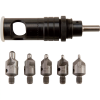Pistolero
Well-Known Member
I got an old Ideal mold at a gun show, cheap, because it was missing the sprue plate and screw.
I have spent some time sawing and filing out a new sprue plate from 4130 0.125 plate today. I was getting
ready to drill the hole for the screw, so I needed to know the size, and decided to check the thread
pitch too. OH darn! This one is a mold block integral with the handles, so pretty early, and clearly before
This one is a mold block integral with the handles, so pretty early, and clearly before
there were standardized screw threads. The screw is #10-36. Eric at Hollowpoint Mold Services sells them,
and I started to order one - with the washer, for $3.00, pretty reasonable for a very oddball screw......
That stopped when I got to the shipping. $9 shipping, meaning it would be a $12 screw. Nope, not
biting.
So tomorrow I will be single pointing a 3/4" long 10-36 screw... ..a challenge, no doubt, but better than
..a challenge, no doubt, but better than
paying $12 and I will learn somthing, no doubt. Fortunately, I don't have to make two of them, the locking
screw on the side is present, and is also 10-36 pitch, which helped a lot in identifying what it was. Far
easier to measure the pitch on a screw than in a hole!
The mold is the 36072 which casts a .360 nominal RN bullet and has a nominal weight of 110 gr. Ideal
catalog calls it a 'light target bullet' for .38 caliber, should be nice in my Colt Police Postive .38 S&W
which is a good shooter, quite accurate.
Papa Roseannadana was right.
Bill
I have spent some time sawing and filing out a new sprue plate from 4130 0.125 plate today. I was getting
ready to drill the hole for the screw, so I needed to know the size, and decided to check the thread
pitch too. OH darn!
 This one is a mold block integral with the handles, so pretty early, and clearly before
This one is a mold block integral with the handles, so pretty early, and clearly beforethere were standardized screw threads. The screw is #10-36. Eric at Hollowpoint Mold Services sells them,
and I started to order one - with the washer, for $3.00, pretty reasonable for a very oddball screw......
That stopped when I got to the shipping. $9 shipping, meaning it would be a $12 screw. Nope, not
biting.
So tomorrow I will be single pointing a 3/4" long 10-36 screw...
 ..a challenge, no doubt, but better than
..a challenge, no doubt, but better thanpaying $12 and I will learn somthing, no doubt. Fortunately, I don't have to make two of them, the locking
screw on the side is present, and is also 10-36 pitch, which helped a lot in identifying what it was. Far
easier to measure the pitch on a screw than in a hole!
The mold is the 36072 which casts a .360 nominal RN bullet and has a nominal weight of 110 gr. Ideal
catalog calls it a 'light target bullet' for .38 caliber, should be nice in my Colt Police Postive .38 S&W
which is a good shooter, quite accurate.
Papa Roseannadana was right.
Bill
Last edited:

